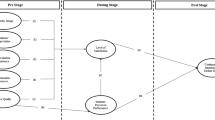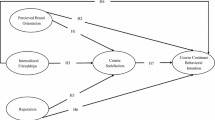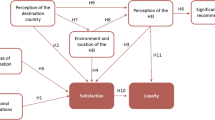Abstract
Relationship with international students can be beneficial to higher education in terms of financial and human resources. For this reason, establishing and maintaining such relationship are usually pre-eminent concerns for higher education providers. In this study, we extended the application of the disconfirmation-expectation model by incorporating three components from subjective task value (i.e., attainment, utility, and intrinsic) to predict the loyalty of international students toward their host countries. On a sample of 410 Vietnamese students enrolled in higher education institutions in over 15 countries across the globe, we employed structural equation model to validate the conceptual model. Our empirical findings revealed that satisfaction and disconfirmation still play important roles as direct and indirect antecedents of international student loyalty, respectively; nonetheless, the most impactful predictor is intrinsic value which directly and indirectly affects loyalty through the mediating roles of satisfaction and disconfirmation. Meanwhile, our findings also unveiled that attainment value has slight impact, but utility value does not have any impact on loyalty. A number of implications might be withdrawn for heads of universities and policy makers while practicing in internationalization of higher education as a consequence of these above results.


Similar content being viewed by others
References
Ahn, J.-H., Han, S.-P., & Lee, Y.-S. (2006). Customer churn analysis: Churn determinants and mediation effects of partial defection in the Korean mobile telecommunications service industry. Telecommunications Policy, 30, 552–568.
Alves, H. (2011). The measurement of perceived value in higher education: A unidimensional approach. The Service Industries Journal, 31(12), 1943–1960.
Andrade, M. S. (2006). International students in English-speaking universities: Adjustment factors. Journal of Research in International Education, 5(2), 131–154.
Ashwill, M. (2016). Vietnamese student numbers growing in the US. Retrieved from: https://www.universityworldnews.com/article.php?story=2016011313585113.
Athiyaman, A. (1997). Linking student satisfaction and service quality perceptions: The case of university education. European Journal of Marketing, 31(7), 528–540.
Australia Bureau Statistics. (2016). International trade: Supplementary information, financial year, 2015–2016. Retrieved from: https://www.abs.gov.au/AUSSTATS/abs@.nsf/DetailsPage/5368.0.55.0032015-16?OpenDocument.
Back, K. J., & Lee, J. S. (2009). Country club members’ perceptions of value, image congruence, and switching costs: An exploratory study of country club members’ loyalty. Journal of Hospitality & Tourism Research, 33(4), 528–546.
Battle, A., & Wigfield, A. (2003). College women’s value orientations toward family, career, and graduate school. Journal of Vocational Behavior, 62(1), 56–75.
Bhattacherjee, A. (2001). Understanding information systems continuance: An expectation-confirmation model. MIS Quarterly, 25(3), 351–370.
Bolton, R. (2018, Feb, 16). Universities are too reliant on income from China, experts say. Retrieved from: https://www.afr.com/news/policy/education/universities-are-too-reliant-on-income-from-china-experts-say-20180216-h0w6vn.
Boulding, W., Kalra, A., Staelin, R., & Zeithaml, V. A. (1993). A dynamic process model of service quality: From expectations to behavioral intentions. Journal of marketing research, 30(1), 7–27.
Chen, Y. C. (2016). The Drive Behind International Student Loyalty in Higher-Educational Institutions: A Structural Equation Model. The Asia-Pacific Education Researcher, 25(2), 315–323.
Chiou, J.-S., & Droge, C. (2006). Service quality, trust, specific asset investment, and expertise: Direct and indirect effects in a satisfaction-loyalty framework. Journal of the Academy of Marketing Science, 34(4), 613–627.
Chiu, C. M., & Wang, E. T. (2008). Understanding Web-based learning continuance intention: The role of subjective task value. Information & Management, 45(3), 194–201.
Choudaha, R., & Kono, Y. (2012). Beyond more of the same: The top four emerging markets for international student recruitment. World Education News & Reviews. Retrieved from: https://wenr.wes.org/2012/10/wenr-october-2012-beyond-more-of-the-same-top-four-emerging-markets-for-international-student-recruitment.
Douglass, J. A., & Edelstein, R. (2009). The global competition for talent: The rapidly changing market for international students and the need for a strategic approach in the US. Center for Studies in Higher Education. Retrieved from: https://cshe.berkeley.edu/publications/global-competition-talent-rapidly-changing-market-internationalstudents-and-need.
Duque, L. C. (2013). A framework for analyzing higher education performance: Students' satisfaction, perceived learning outcomes, and dropout intentions. Total Quality Management & Business Excellence, 25, 1–21.
Eccles, J. S. (1987). Gender roles and women's achievement-related decisions. Psychology of Women Quarterly, 11(2), 135–172.
Edvardsson, B., Tronvoll, B., & Gruber, T. (2011). Expanding understanding of service exchange and value co-creation: A social construction approach. Journal of the Academy of Marketing Science, 39(2), 327–339.
Ehrenberg, R. G. (2012). American higher education in transition. The Journal of Economic Perspectives, 26(1), 193–216.
Field, A. M. (1999). The college student market segment: A comparative study of travel behaviors of international and domestic students at a southeastern university. Journal of Travel Research, 37(4), 375–381.
Floh, A., Zauner, A., Koller, M., & Rusch, T. (2014). Customer segmentation using unobserved heterogeneity in the perceived-value–loyalty–intentions link. Journal of Business Research, 67(5), 974–982.
Fryrear, A. (2015, July, 27). What is a good survey response rate?. Retrieved from: https://www.surveygizmo.com/resources/blog/survey-response-rates/.
Grace, B. Y., & Kim, J. H. (2008). Testing the mediating effect of the quality of college life in the student satisfaction and student loyalty relationship. Applied Research in Quality of Life, 3(1), 1–21.
Grönroos, C., & Voima, P. (2013). Critical service logic: Making sense of value creation and co-creation. Journal of the Academy of Marketing Science, 41(2), 133–150.
Ha, H. Y., & Janda, S. (2008). An empirical test of a proposed customer satisfaction model in e-services. Journal of Services Marketing, 22(5), 399–408.
Haigh, M. J. (2002). Internationalisation of the curriculum: Designing inclusive education for a small world. Journal of Geography in Higher Education, 26(1), 49–66.
Helgesen, Ø., & Nesset, E. (2007). Images, satisfaction, and antecedents: Drivers of student loyalty? A case study of a Norwegian University College. Corporate Reputation Review, 10(1), 38–59.
Hennig-Thurau, T., Langer, M. F., & Hansen, U. (2001). Modeling and managing student loyalty: An approach based on the concept of relationship quality. Journal of service research, 3(4), 331–344.
Hoogland, J. J., & Boomsma, A. (1998). Robustness studies in covariance structure modeling: An overview and a meta-analysis. Sociological Methods & Research, 26(3), 329–367.
Jones, M. A., Reynolds, K. E., & Arnold, M. J. (2006). Hedonic and utilitarian shopping value: Investigating differential effects on retail outcomes. Journal of Business Research, 59(9), 974–981.
Khawaja, N. G., & Dempsey, J. (2008). A comparison of international and domestic tertiary students in Australia. Australian Journal of Guidance and Counselling, 18(01), 30–46.
Kumar, V., Dalla Pozza, I., & Ganesh, J. (2013). Revisiting the satisfaction–loyalty relationship: Empirical generalizations and directions for future research. Journal of Retailing, 89(3), 246–262.
Liao, C., Chen, J. L., & Yen, D. C. (2007). Theory of planning behavior (TPB) and customer satisfaction in the continued use of e-service: An integrated model. Computers in Human Behavior, 23(6), 2804–2822.
Marginson, S. (2007). Global position and position taking: The case of Australia. Journal of Studies in International Education, 11(1), 5–32.
Ministry of Education (2017, September, 20). The fifth Taiwan-Vietnam Education Forum opens new prospects for Taiwan-Vietnam Educational Cooperation. Retrieved from: https://english.moe.gov.tw/cp-13-17267-645DC-1.html.
Narayandas, N. (1996). The link between customer satisfaction and customer loyalty: An empirical investigation. Harvard Business School: Division of Research.
Oliver, R. L. (1980). A cognitive model of the antecedents and consequences of satisfaction decisions. Journal of Marketing Research, 17(4), 460–469.
Pandža Bajs, I. (2015). Tourist perceived value, relationship to satisfaction, and behavioral intentions: The example of the Croatian tourist destination Dubrovnik. Journal of Travel Research, 54(1), 122–134.
Parasuraman, A., & Grewal, D. (2000). The impact of technology on the quality-value-loyalty chain: a research agenda. Journal of the Academy of Marketing Science, 28(1), 168–174.
Pham, H. (2013). As degree mills proliferate, new measures published. Retrieved from: https://www.universityworldnews.com/article.php?story=2013082311472624.
Pham, H. H., & Lai, S. L. (2016). Higher education as an extended duration service: An investigation of the determinants of Vietnamese overseas student loyalty. Journal of Studies in International Education, 20(5), 454–471.
Phan, L. H. (2016). Student identities in transnational space: Vietnam in focus. In Transnational Education Crossing ‘Asia’ and ‘the West’ (pp. 151–174). Routledge.
Phuong, H. (2016). Vietnamese oversea students mostly stay in Japan. Retrieved from: http://vietnamnet.vn/vn/giao-duc/du-hoc/du-hoc-nhat-ban-du-hocmy-du-hoc-sinh-viet-namdong-nhat-o-nhat-337144.html
Sawir, E. (2005). Language difficulties of international students in Australia: The effects of prior learning experience. International Education Journal, 6(5), 567–580.
Study Kyoto. (2017). Free Entry to Kyoto’s Museums and Heritage Sites? For Kyoto International Students, yes! Retrieved from: https://www.studykyoto.jp/en /magazine /2017/08/09/free-entry-for-students/
Sweeney, J. C., & Soutar, G. N. (2001). Consumer perceived value: The development of a multiple item scale. Journal of Retailing, 77(2), 203–220.
Tellis, G. J. (1988). Advertising exposure, loyalty, and brand purchase: A two-stage model of choice. Journal of Marketing Research, 25, 134–144.
Trines, S. (2017, November, 8). Education in Vietnam. Retrieved from: https://wenr.wes.org/2017/11/education-in-vietnam.
University Australia. (2016, November, 21). International education generates a record $20.3 billion for Australia. Retrieved from: https://www.universitiesaustralia. edu.au/Media-and-Events/media-releases/International-education-generates-a-record--20-3-billion-for-Australia#.Wdy1KmKCzC8
Varas, J. (2016 April, 5). The native-born STEM shortage, American Action Forum . Retrieved from: https://www.americanactionforum.org/research/native-born-stem-shortage/.
VNA. (2018, July, 5). Vietnam ranks 5 th international students in Australia in February. Retrieved from: https://english.vov.vn/society/vietnam-ranks-5th-in-international-students-in-australia-in-february-374090.vov.
Wigfield, A., & Eccles, J. S. (1989). Relations of expectancies and values to students' math grades and intentions. San Francisco: In Meeting of the American Educational Research Association.
Zhou, Y., Jindal-Snape, D., Topping, K., & Todman, J. (2008). Theoretical models of culture shock and adaptation in international students in higher education. Studies in higher education, 33(1), 63–75.
Funding
This research is funded by Vietnam National Foundation for Science and Technology Development (NAFOSTED).
Author information
Authors and Affiliations
Corresponding author
Additional information
Publisher’s Note
Springer Nature remains neutral with regard to jurisdictional claims in published maps and institutional affiliations.
Rights and permissions
About this article
Cite this article
Pham, HH., Lai, S.L. & Vuong, QH. The Role of Subjective Task Value in Forming Satisfaction and Loyalty Among Vietnamese International Students: A Structural Equation Model. Asia-Pacific Edu Res 28, 399–409 (2019). https://doi.org/10.1007/s40299-019-00439-3
Received:
Accepted:
Published:
Issue Date:
DOI: https://doi.org/10.1007/s40299-019-00439-3




